A lot of shaking going on: Sawmill manager ensures steady production numbers
Published 12:05 am Friday, February 27, 2015
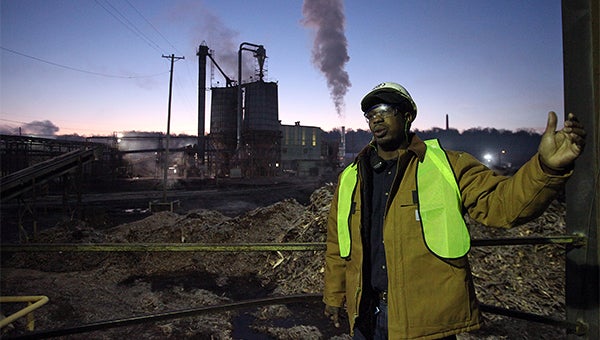
Interim plant manager Mike Williams talks about the sawmill at Anderson-Tully Lumber Company. (Justin Sellers/The Vicksburg Post)
There’s a lot shaking in Mike William’s second-floor office inside the Anderson-Tully sawmill. /// Every few seconds, as new logs weighing thousands of pounds are loaded into the hardwood mill, the vibrations push and pulse though the building like a small magnitude earthquake.
“I don’t even feel it really,” Williams said as the next log causes the floor in his office to vibrate.
He’s had plenty of time to get used to the shake, rattle and roll of the sawmill business.
Williams began working at the plant 19 years ago as a maintenance technician. He worked his way up through the ranks and is now the interim mill manager, meaning he supervises one of the largest, fastest moving and most complex hardwood sawmills on the continent.
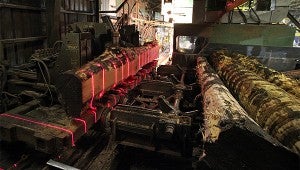
Lasers stripe a log on a machine that strips rough edges inside a sawmill at Anderson-Tully Lumber Company. (Justin Sellers/The Vicksburg Post)
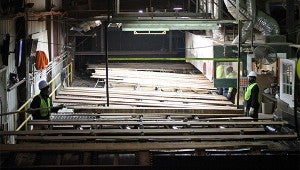
Employees inspect boards before they are sent out of the sawmill at Anderson-Tully Lumber Company. (Justin Sellers/The Vicksburg Post)
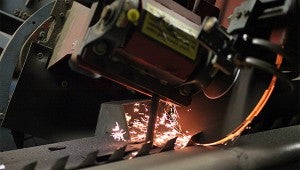
A grinder sharpens sawmill blades at Anderson-Tully Lumber Company. (Justin Sellers/The Vicksburg Post)
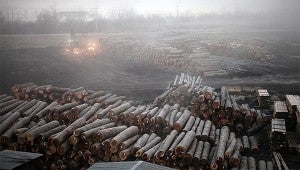
Fog and frost covers the lumberyard at Anderson-Tully Lumber Company. (Justin Sellers/The Vicksburg Post)
The shaking of loading logs and whirl of the saws begins while plenty of Warren County residents are still nestled in bed sawing proverbial logs of their own.
“The guys start up at 5 a.m. on one side of the plant so we’re ready to run. The rest starts up at 6, but we have to have logs ready,” Williams said.
It’s a long, loud, rumbling process that over the course of the day creates hundreds of thousands of hardwood boards each day. The boards are eventually used to make furniture or for other building projects.
“It depends on the species that we are cutting and the size of the logs. Red oak is more difficult and the logs are bigger. Hackberry goes fast. But we average between 150,000 and 250,000 boards for the day,” Williams said.
That production amount is a far cry from when Anderson-Tully was founded in 1899 as a manufacturer of vegetable crates. Certainly Christopher J. Tully never imagined laser guided saws and conveyer belts whizzing by at almost blinding speeds.
Some things haven’t changed much. At 5 a.m. in winter, the modern mill is still freezing cold. Safety yellow painted metal catwalks that maze through the plant are covered in frost, and industrial space heaters are set up near workers bundled up in coveralls and thick leather gloves. They’re also required to wear earplugs — sawing, of course, is incredibly loud — bright green safety vests, and hardhats.
“It’s safety first,” Williams said.
The process of turning once living trees into fine hardwood lumber begins in the mill’s yard where giant logs are kept wet for about six months. From they are moved by a small front-end loader with a specially designed log-carrying bucket into a massive machine that strips bark.
“This is where it all gets started right here,” Williams said. “Our customers don’t want any bark on their boards. And sometimes the bark is rotten, so the stripper makes sure the saws don’t cut into anything rotten.”
Rather than the warm smell of sawdust most people associate with sawing lumber, then the mill almost always smells of a mix of syrupy sweet sap thanks to the moist logs.
Logs whizz through the plants automated conveyor belts at an astounding pace from there and are sent to a laser guided cutter than removes edges, essentially making them resemble a rough, oversized railroad tie.
From there, they are sawed and pared down until only the best wood is left. So what happens to all the bark, scraps and irregular, unusable pieces?
“We don’t waste anything. We use the scraps for the power plant. They are burned and make steam to run the kiln dryer,” Williams said.
Unfinished boards go through a visual inspection and are coded by hand with what looks like a florescent marker. Inspectors look for knots, pieces of bark and the straightness of the cut. Another laser guided machine kicks out boards that don’t pass inspection. The rest end up being dried, sent though the mill again or end up being loaded onto trucks and shipped for sale.
The plant operates 24 hours a day, and boards are churned out the vast majority of the time. There are breaks throughout the day for servicing the many machines in the mill.
“We’ve got a preventative maintenance program on every piece of equipment in the mill,” Williams said.
Still, maintenance goes on throughout the day. Saws are limited on the number of hours they can run without being sharpened. And if something goes wrong with a piece of machinery during the day, Williams is on it.
“My job is to make sure everything is running while we run,” he said.





